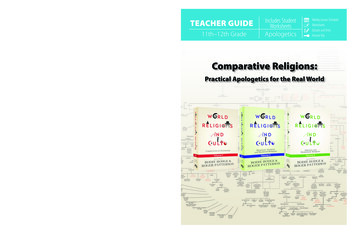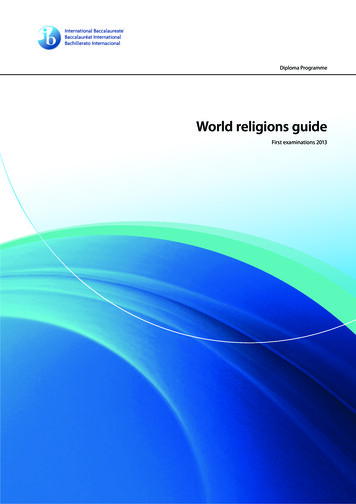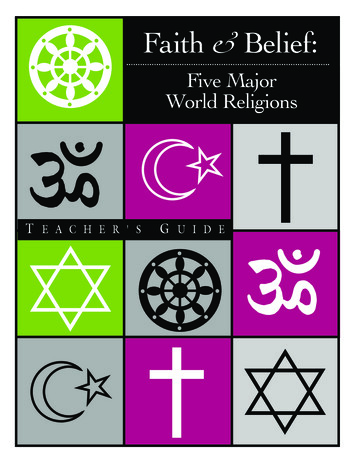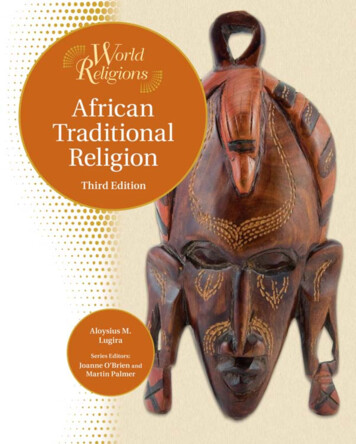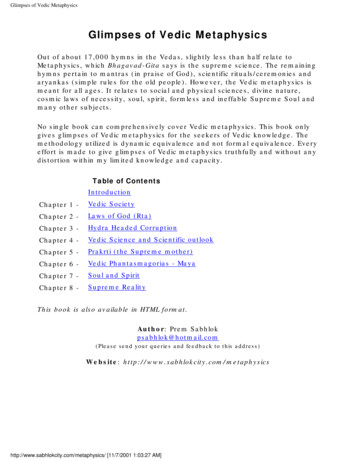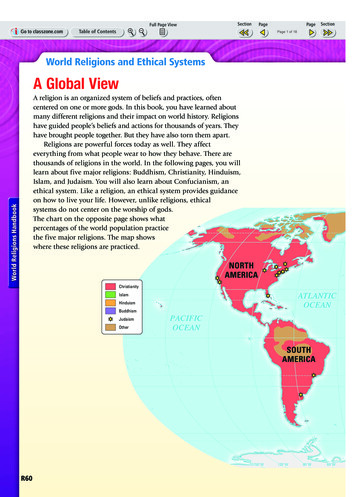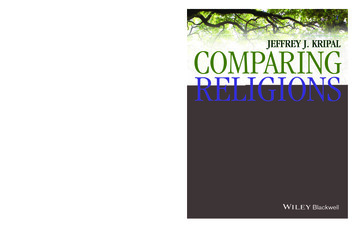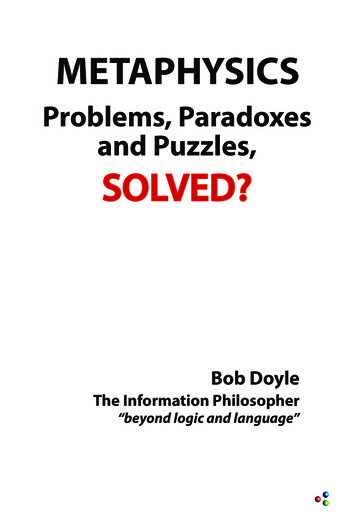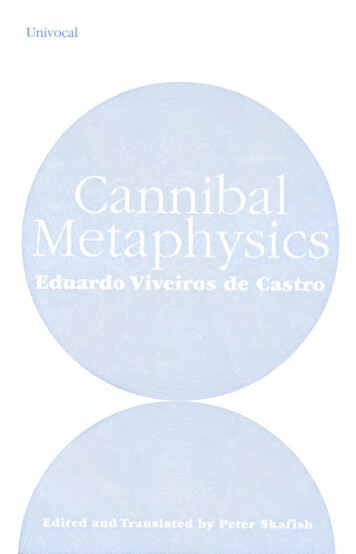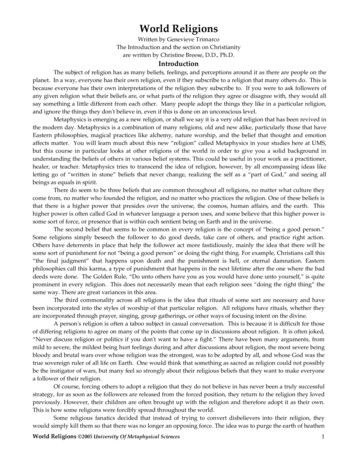
Transcription
World ReligionsWritten by Genevieve TrimarcoThe Introduction and the section on Christianityare written by Christine Breese, D.D., Ph.D.IntroductionThe subject of religion has as many beliefs, feelings, and perceptions around it as there are people on theplanet. In a way, everyone has their own religion, even if they subscribe to a religion that many others do. This isbecause everyone has their own interpretations of the religion they subscribe to. If you were to ask followers ofany given religion what their beliefs are, or what parts of the religion they agree or disagree with, they would allsay something a little different from each other. Many people adopt the things they like in a particular religion,and ignore the things they donʹt believe in, even if this is done on an unconscious level.Metaphysics is emerging as a new religion, or shall we say it is a very old religion that has been revived inthe modern day. Metaphysics is a combination of many religions, old and new alike, particularly those that haveEastern philosophies, magical practices like alchemy, nature worship, and the belief that thought and emotionaffects matter. You will learn much about this new “religion” called Metaphysics in your studies here at UMS,but this course in particular looks at other religions of the world in order to give you a solid background inunderstanding the beliefs of others in various belief systems. This could be useful in your work as a practitioner,healer, or teacher. Metaphysics tries to transcend the idea of religion, however, by all encompassing ideas likeletting go of “written in stone” beliefs that never change, realizing the self as a “part of God,” and seeing allbeings as equals in spirit.There do seem to be three beliefs that are common throughout all religions, no matter what culture theycome from, no matter who founded the religion, and no matter who practices the religion. One of these beliefs isthat there is a higher power that presides over the universe, the cosmos, human affairs, and the earth. Thishigher power is often called God in whatever language a person uses, and some believe that this higher power issome sort of force, or presence that is within each sentient being on Earth and in the universe.The second belief that seems to be common in every religion is the concept of “being a good person.”Some religions simply beseech the follower to do good deeds, take care of others, and practice right action.Others have deterrents in place that help the follower act more fastidiously, mainly the idea that there will besome sort of punishment for not “being a good person” or doing the right thing. For example, Christians call this“the final judgment” that happens upon death and the punishment is hell, or eternal damnation. Easternphilosophies call this karma, a type of punishment that happens in the next lifetime after the one where the baddeeds were done. The Golden Rule, “Do unto others have you as you would have done unto yourself,” is quiteprominent in every religion. This does not necessarily mean that each religion sees “doing the right thing” thesame way. There are great variances in this area.The third commonality across all religions is the idea that rituals of some sort are necessary and havebeen incorporated into the styles of worship of that particular religion. All religions have rituals, whether theyare incorporated through prayer, singing, group gatherings, or other ways of focusing intent on the divine.A personʹs religion is often a taboo subject in casual conversation. This is because it is difficult for thoseof differing religions to agree on many of the points that come up in discussions about religion. It is often joked,“Never discuss religion or politics if you donʹt want to have a fight.” There have been many arguments, frommild to severe, the mildest being hurt feelings during and after discussions about religion, the most severe beingbloody and brutal wars over whose religion was the strongest, was to be adopted by all, and whose God was thetrue sovereign ruler of all life on Earth. One would think that something as sacred as religion could not possiblybe the instigator of wars, but many feel so strongly about their religious beliefs that they want to make everyonea follower of their religion.Of course, forcing others to adopt a religion that they do not believe in has never been a truly successfulstrategy, for as soon as the followers are released from the forced position, they return to the religion they lovedpreviously. However, their children are often brought up with the religion and therefore adopt it as their own.This is how some religions were forcibly spread throughout the world.Some religious fanatics decided that instead of trying to convert disbelievers into their religion, theywould simply kill them so that there was no longer an opposing force. The idea was to purge the earth of heathenWorld Religions 2005 University Of Metaphysical Sciences1
people. This was actually a righteous idea and many thought they were doing the right thing by releasing theirvictims from faulty beliefs, religions and practices. As mentioned above, “doing the right thing” is not the samein every religion.Religion has its uses. Some metaphysicians would say that religion itself is elementary to the trueknowledge that all beings, from the smallest particle in an atom to the largest celestial body in the universe, andeverything in between, is God. Others would say that it is an excellent beginning point for those who are true tothe inner self and are called to explore their spirituality. Others would say that religion fits right in withmetaphysics and that it is not necessary to stop practicing one’s religion in order to be a metaphysician. That isone of the nicer aspects of metaphysics, this tendency toward all‐inclusiveness toward other religions.Religion could be seen as a vehicle for training the human condition to be more compassionate, loving,and tolerant of all things, but this is not the end result in Metaphysics. Correcting the faults in the humancondition is only a beginning, and in some metaphysical circles not even necessary. Religions usually specifycertain rules, beliefs about reality and the divine, and denote punishments for breaking the rules. However, in anall accepting universe that allows all things to have free will, static rules, beliefs, and practices cannot stay thesame forever because the nature of the universe itself is a movement between chaos and patterns, back to chaosand them back to patterns again. Change is the only thing that is inevitable. Many religions do not allow for thisinevitable, natural movement of the powers that be in our universe, although some do. In fact many rules,beliefs, and practices are outdated in this day and age, for those rules were created for a different time‐period, adifferent human psychology, and different cultures that may not apply in the modern day. Therefore it isimportant that rules, beliefs, and practices can change as the times change and the evolution of the humanunderstanding of the nature of reality progresses. Metaphysics itself is perhaps a response to this need forspiritual change as the world and humanity changes.Religion helps to focus the seeker who has just begun to explore the deeper aspects of life, and for theadvanced seeker it may serve as a focus of intention. However, religion itself must eventually be left behind fortrue enlightenment to take place, according to some concepts in metaphysics. If each of us is a part of God, orperhaps even God itself, then no religion can truly define what we are. Religion can only serve as a guide as weseek enlightenment on the matter of who we are.Many of your clients, patients, and students will come from various religious backgrounds. Some willhave no religious background at all. Either way, it is useful for you to know what these religious backgrounds,beliefs and practices are. By knowing where the seeker is coming from you may know better how to work withhim or her. Be courteous if the seeker is still very dedicated to a particular religion, for you will not assist anyoneby telling him or her to immediately throw away something that he or she has found valuable and useful in hisor her life‐path. This can polarize a seeker immediately, and he or she will not want to hear anything else youhave to say. So begin gently, and let him or her decide when it is time to move beyond religion, or how andwhen he or she decides to incorporate that religion into the mix with the concepts you are teaching or practicing.Not everyone feels the need to leave religion behind altogether, and they may find that their particular religionfits quite easily with what you are teaching or practicing, especially if it has metaphysical flavors to begin with.Remember, religion may have served you at one time as well, and perhaps it still is, and this may be the case forothers as well. Religion serves as a focus for divine intent, a wish to do good, and belief in a higher power(s) thatis benevolent and wishes to assist humankind. This can only be a good thing!So let us now look at the various religions of the world, take a peek at their practices and beliefs. Let usfind the value in each and how they have served mankind in the search for understanding of God and self.Review Of Literature(Exam questions are not drawn from the following material in this section, Review Of Literature)In writing this course I used the Sourcebook Of World Religions: An Interfaith Guide To Religion AndSpirituality (2000) as a guide for which religions I wanted to cover. It presents more than twenty religions andspiritual paths and hundreds of articles, quotations, sacred text, and prayers. It even has new material on the1999 Parliament Of The World’s Religions. Each chapter has at least one contributing author and most have threeor more. Essays include pieces by Thomas Berry on the cosmology of various religions, Thomas Keating’sguidelines for interreligious dialogue, and Marcus Braybrooke’s survey of the interfaith movement, all exploringbuilding community among religions. The editor is Joel Beversluis. He has worked in academic religiouspublishing and volunteered in ecology, interfaith and peace organizations. He went to Western MichiganWorld Religions 2005 University Of Metaphysical Sciences2
University and studied comparative religion there. As of 2000 he was Editor and Publisher of CoNexus Press.There are four parts to this book: Who Are We?, Becoming a Community of Religions, Choosing Our Future andSelected Resources for the Community of Religions.In the reference section of most libraries there is an encyclopedia‐style set of volumes called Man, Myth &Magic (1985), by editor in chief Richard Cavendish. It is a great reference guide for just about anything one wouldlike to learn about in the areas that the title suggests (man, myth and magic). There is an extensive list of editorialboard members, consultants, and assistant editors. These books cover a wide range of subjects includingwitchcraft (vol. 22), Jesus (Vol. 6), and a bit on new religious movements (Vol. 7).A great book for learning about Buddhism in many different countries and how it has been changed isThe Experience of Buddhism (2002) by John S. Strong. It has two parts: “The Experience of Buddhism in SouthAsia” and “The Development of Buddhism Outside India.” The sub categories begin with the life story ofBuddha and its ramifications and go through the experience of the Sangha to the Dharma and practices ofBuddhists in Sri Lanka, Southeast Asia, the Tibetan cultural area, China, Japan, and the West. It has a helpfulguide to the transliteration and pronunciation of Buddhist terms and a two‐page map of part of the continent ofAsia titled “The World of Buddhism.”Another very helpful book I used is A World Religions Reader (1997). It has chapters on nine differentreligions, which include Secular Humanism, Buddhism, and Judaism. Each chapter begins with a map thatshows the population and location of the people in that religion in the world. This book combines classicstatements of some of the major thinkers and institutions and includes the words of Martin Luther King and JohnLennon with passages from the scriptures. Each chapter is organized by five headings, they are “The ReligiousMind” “World Views,” “Institutions and Rituals,” “Ethical Expression,” and “Modern Expression.” There is alsoa selected summary of beliefs, a list of historical highlights, major festivals, and key terms at the end of eachchapter. The editor, Ian Markham, is a Professor of Theology at Liverpool Hope University College. He teachesInterface Ethics and Ecumenical Theology. He is the author of Plurality and Christian Ethics (CUP), and also sits onthe Council of the Advertising Standards Authority.The World’s Religions (1991) is a completely revised and updated edition of Huston Smith’s The ReligionsOf Man (original copyright 1958). It is widely considered the best introduction to the world’s religions and hasdetailed, but still very readable chapters on Buddhism, Confucianism, Islam and Christianity, among others, andfeatures sections on the inner dimensions of these great religions. Huston Smith is a leading figure in thecomparative philosophy of religion and is regarded as the most accessible and eloquent authority on the historyof religions. He has taught at MIT, Washington University, and Syracuse. In 1991 he was currently a visitingprofessor at the University of California, Berkley.Edward Rice wrote Ten Religions of the East (1978) a great book with stories of the founders and spiritualleaders of ten of the world’s less well known faiths and what these religions have evolved into today. It coversthe Jains, the Zoroastrians, the Sikhs, Taoism and Confucianism, Bon and Shinto, Cao Dai, the Baha’I Faith, andTheosophy. Edward Rice is a writer, artist, and photographer who illustrated the book and added his ownphotographs as well. He has written Marx, Engels, and the Workers of the World, The Ganges: A Personal Encounterand The Five Great Religions as well as others.Nature Religions In America: From the Algonkian Indians To The New Age (1990) is a valuable resource ofreligions that have been at the heart of American Culture, but previously have not been acknowledged. Theauthor, Catherine L. Albanese, covers influential people such as the Hutchinson Family Singers to ThomasJefferson and John Muir that have had some part in Nature Religions. Catherine L. Albanese is professor ofreligious studies at the University of California, Santa Barbara. She is the author of many articles and books inAmerican religious history.John M. Koller and Patricia Koller have written a valuable book titled A Sourcebook In Asian Philosophy(1991). It is a collection of English translations of the basic texts that have shaped the major Asian philosophicaltraditions. It incorporates all the fundamental texts from Asian philosophy, which give great insight into thesetraditions. It begins with a helpful pronunciation guide. It is separated into three parts: Hindu texts, Buddhisttexts, and Chinese texts, and includes chapters on Vedas and Upanisads, Samkhya, Yoga, Jainism, the rise of theMahayana, Zen, the vision of Confucius, Chinese Buddhism and much more. The authors have twenty‐ fiveyears of experience teaching introductory courses in Asian philosophy.World Religions 2005 University Of Metaphysical Sciences3
This next book is a survey of world religions that are active in the twentieth century. A Handbook OfLiving Religions (1984), edited by John R. Hinnells, was very useful in writing this course because it covers themajor religions and regional studies of Japan and China, among others. Collaborators include scholars fromuniversities in many countries. Their goal in writing this book was to outline developments that have takenplace and assess the variety, vitality and impact of the world’s religions in modern times.Paul Williams is a professor on Indian and Tibetan philosophy at the University of Bristol. In his bookBuddhist Thought: A Complete Introduction to the Indian Tradition (2000) he shares the central concepts of classicalIndian Buddhist thought. He makes even abstract and complex ideas accessible through his clear and lucid style.In this book there is also the most up‐to‐date survey of Buddhist Tantra in India. Paul Williams is also Co‐Director of the Centre for Buddhist Studies at the University of Bristol.The Way of Zen (1959) by Alan W. Watts was the first comprehensive explanation of Zen Buddhism, it isan introduction to the theory and practice of this school of thought. The book is a study of the historical andcultural growth of this philosophy. It is split up into two parts, Background & History, and Principles & Practice.Alan W. Watts has been an editor, minister, and college professor. He has lectured at several universities, and isknown as a stimulating and unconventional philosopher.Another good source on Zen is the book Zen Buddhism (1956), it is the selected writings of D.T. Suzuki,edited by William Barrett. It includes selections from D.T. Suzuki’s books Essays in Zen Buddhism, Studies in Zen,and The Zen Doctrine of No‐Mind. It is a good introduction for the general reader of the history and spirit of Zen.William Anderson has written an interesting book on archetypes and our oneness with the Earth that Iused a bit for the section on Wicca and Nature Spirituality. It is titled Green Man (1990) and is the record of aquest for this archetype through religion, art, folklore, and architecture from prehistory to the present. Theauthor has won the “Silver Pen” award in poetry for his scholarly Dante the Maker. He lectures widely and haswritten for Parabola.Dr. Lauren Artress’ book Walking a Sacred Path: Rediscovering the Labyrinth as a Spiritual Tool (1995) is aninteresting study on this form of meditation where a person walks a painted path while in a trance and cantranscend the limits of still meditation. Reverend Dr. Lauren Artress is Canon for Special Ministries at SanFrancisco’s Grace Cathedral and has founded a project addressing the need for spirituality in our time calledQuest: Grace Cathedral Center for Spiritual Wholeness. She created the Labyrinth Project as well.Looking into Judaism I found a valuable book called Essential Judaism: A Complete Guide To Beliefs,Customs, and Rituals (2000) by George Robinson. It covers a great deal on the subject including chapters on theJewish idea of Prayer, what daily services are like, the evolution of the prayer book, the thirty‐nine categories offorbidden work and all the holidays and festivals. George Robinson holds the award for excellence in Jewishjournalism which is the Simon Rockower Award. He frequently has articles in The New York Times, TheWashington Post, and Newsday, as well as some Jewish publications.The New Religions (1970) by Jacob Needleman is a book on how young America is reaching inwardthrough Zen, yoga, the Tibetan Lamas, and other teachings. The author has a Ph. D. in Philosophy from Yale andtaught at San Francisco State College.The I Ching is also called the Book of Changes and is the oldest surviving text in Chinese culture,Confucianism and Taoism have their beginnings in the I Ching. Originally it was a book of divination and can beused by throwing three coins, asking a question and look to the book for the answer. The version I consulted wasedited by James Legge (1996) who leads us through the complex and subtle world of the I Ching.On researching the Baha’I Faith I found a book called The Dynamic New Religion: Baha’I Faith (1967) byJessyca Russell Gaver. It is filled with all the information on this new creed and includes pieces on theinternational aspects of the faith, America’s destiny in the Baha’I world and the path of the true believer.Michael Harner, Ph.D, has written an intriguing book on Shamanism called A Guide To Power and Healing:The Way Of The Shaman (1982). It shares the art of shamanic healing step by step through simple techniques andexercises. There are some great adventure stories and intelligent wisdom inside. The author has practicedshamanism and shamanic healing for more than twenty‐five years and has tried to bring them back tocontemporary life. He is head of The Foundation for Shamanic Studies in Norwalk Connecticut.Shambhalla (1978) by Nicholas Roerich is a record of his spiritual journey through Central Asia and Tibet.It has a lot of good information on subjects such as, Buddhism in Tibet, Dreams and Gurus.World Religions 2005 University Of Metaphysical Sciences4
An in depth book on the beginnings of Hinduism is The Origins & Development of Classical Hinduism(1989) by A.L. Basham. It is a small book based on a series of five lectures given on ten key university campusesin the U.S. during 1984 and 1985 by A.L. Basham. They were his last public lectures in North America before hedied in 1986. As the title suggests, it is a look at the start of this ancient religion and goes on to investigate thedevelopment as well as the rise of other mystical and ascetic traditions, such as Buddhism and Jainism. Thisauthor was one of the world’s foremost authorities on ancient Indian culture and religion.The Bhagavad Gita is a famous poem in Hindu literature and is part of the Mahabharata, the great Indianepic. The Bhagavad Gita is a dialogue between Lord Krishna and Prince Arjuna the morning of a climactic battle.Krishna provides the Prince with spiritual means to take action under trying circumstances. Mainly it is a poemabout the moral universe of Hinduism. The version I used was translated by Eknath Easwaran (copyright 2000).He was director of the Blue Mountain Center of Meditation, which he founded in 1961 in Berkley, CA. He is theauthor of many books on spiritual life.A helpful book on Islam by John L. Esposito is What Everyone Needs To Know About Islam (2002). It is abook written after September 11th by this leading expert. It is presented in a question and answer format. Itcontains the question about Islam that people most want to know. It goes from the basic questions to the mostcomplicated aspects of this culture; there is a special section on terrorism and violence. The author is theUniversity Professor of Religion and International Affairs and founding director of the Center forMuslim/Christian Understanding at the Walsh School of Foreign Service, Georgetown University.Another book from John L. Esposito that I used was Islam: The Straight Path (1998). Written in the time ofthe Iranian revolution, Gulf War, the World Trade Center bombing it is a guide to Islamic history, faith, culture,and politics.The Pillars of Islam: An Introduction To The Islamic Faith (1990) by Frances Gumley & Brian Redhead is abasic read with information on the faith of Islam. Frances Gumley was the first woman to edit the Catholic Heraldand has been the producer of religious programs for the B.B.C. She has co‐authored two other books with BrianRedhead who is a well known broadcaster who regularly presents the Today Program on Radio Four.Yvonne Yazbeck Haddad and Adair T. Lummis wrote a book that I used called Islamic Values in theUnited States: A Comparative Study (1987). It is a sociological study presenting the experiences and problems oftoday’s immigrant Mulims in the context of Islam’s 100 year history in America and internationally. Ms. Haddadis Professor of Islamic History at the University of Massachusetts, Amherst. Adair T. Lummis is ResearchAssociate at the Center for Social and Religious Research at the Hartford Seminary.Islam: Opposing Viewpoints (2001), edited by Jennifer A. Hurley, is part of the Opposing Viewpoints Series.It is filled with diverse opinions, from experts, policy makers, and concerned citizens. There are many articles,speeches and long excerpts from books organized around substantive issues within the general debate.Another introductory book on Islam is Understanding Islam: An Introduction to the Muslim World (1995) byThomas W. Lippman. It outlines the sacred book, the Koran and explains “The Five Pillars Of Faith.” It alsodescribes the differences that divide Islam, and most importantly shows the influence of Islam on world affairs.The author served in Cairo as Washington Post bureau chief for the Middle East for over three years, observingthis turbulent region.An insightful and easy to read book called Islam Unveiled: The True Desert Storm (1991) by Dr. Robert A.Morey was a good resource on everything you need to know about Islam. The author is the Executive Director ofthe Research and Education Foundation and is the author of over twenty books.The Essential Koran: The Heart of Islam (1993) translated by Thomas Cleary is a good book for a beginner. Itis an introductory selection of readings from the Qur’an, which are made very accessible for an outsider tounderstand and get to know the basics of Islamic spirituality.A book on the somewhat forgotten tradition in Judaism is Jewish Meditation: A Practical Guide (1985) byAryeh Kaplan. It is a step‐by‐step introduction and covers mantra meditation, contemplation and visualizationwithin a Jewish context. The author was a well‐known Orthodox rabbi who taught Jewish meditation.Judaism (1961), edited by Arthur Hertzberg, is a collection of the classic authorities on Jewish spiritualityand their ideas about the basic values and affirmations of this religious way of life.The Joy of Ritual (1999) is from the author Barbara Biziou. She has shared some great ideas on spiritualcelebrations, making every day sacred and using ritual to enhance our daily routines. She is the president of BlueLotus Productions and has produced audiotapes on meditation, basic metaphysics, and ritual.World Religions 2005 University Of Metaphysical Sciences5
Venerable Master Hua’s Talks on Dharma, Volume Five (1999) is from this great master who explains thescriptures. The book has a side‐by‐side Chinese/English format. He did many things in his lifetime such asestablishing monasteries, setting forth principles and founding the Dharma Realm Buddhist Association inAmerica.Another good resource for learning about Buddhism is Buddhism: A Brief Introduction (1996). It is alsofrom the teachings of the Venerable Master Hsuan Hua. It covers all the basics of this religion and has aninterview with the Master about the schools of Buddhist practice.Introduction To Tibetan Buddhism (1995) by John Powers is an in‐depth look at this area of Buddhismincluding a look at its Eastern Indian background, Tibetan culture, and the four schools of Tibetan Buddhism.The author is an assistant professor in the Department of Religion at Wright State University, has an M.A. inIndian Philosophy from McMaster University and a Ph.D. in Buddhist Studies fro the University of Virginia.The whole story of Buddha’s life can be found in The Buddha: His Life Retold (1989). It is an epic tale withsamplings of his 84,000 discourses, miracles and the events that made up his life. The author, R.A. Mitchell is selfeducated in Pali and Sanskrit and did his graduate work at Harvard in Physics and Astronomy, he has had alifelong interest in Buddhism.A useful book that predominantly covers the five great faiths of Hinduism, Buddhism, Judaism, Islam, andChristianity is Great Religions of the World (1978). It is compiled by the National Geographical Society, editoremeritus, Melville Bell Grosvenor, and over 15 contributing authors. These scholars, National Geographic writersand photographers bring this book together with 370 illustrations and many interesting accounts of these religions.Forerunners and Rivals of Christianity: From 330 B.C. to 330 A.D. (1964) by Francis Legge is a two‐volumebook bound as one. It goes into a full description of the religious beliefs and practices of those times. It is veryimportant for understanding the growth and development of the Christian religion. Francis Legge was aprominent scholar in Biblical archeology and related subjects for more than thirty years.The Holy Qur’an (1917) is the holy scriptures of the Islamic Faith. The edition I used is over 1,200 pageslong and has side‐by‐side Arabic and English translations.The edition of the Bible that I used was Holy Bible: New American Standard, red letter edition, published byBroadman & Holman.The Teaching Company’s The Great Courses has versions of the Old and New Testament in 2 volumes each.The Old Testament is presented by Professor Amy‐Jill Levine, Vanderbilt University Divinity School. The OldTestament is presented by Professor Bart D. Ehrman, University Of North Carolina at Chapel Hill. These aresmall transcripts of lectures and course guidebooks.Time‐Life Books has an interesting resource of supernatural and scientific findings titled Mysteries of theUnknown: Mind Over Matter (1988), editor in chief Jason McManus with many contributors. It has sections onvarying subjects like physical powers of will, putting psycho‐kinesis to the test and essays on the world ofpoltergeists, the hypnotic state and turning visions into reality.The Science of Mind (1938) is a book by Ernest Holmes. It is about the religion of the same name and issplit up in six parts with meditations at the end.Hans‐Joachim Schoeps wrote the book The Religions of Mankind: Their Origin and Development (1966). Itwas very helpful in researching the roots of many religions and how they are similar.African ReligionsTraditional African religions have an emphasis on salvation and wholeness in this world, here and now.In the Sourcebook Of The World’s Religions (2000), in the chapter Introduction To African Traditional Religions, Rev.Dr. Abraham Akrong tells us, “Because Africans believe that life is a complex web of relationships that mayeither enhance and preserve life or diminish and destroy it, the goal of religion is to maintain those relationshipsthat protect and preserve lif
World Religions 2005 University Of Metaphysical Sciences 3 University and studied comparative religion there. As of 2000 he was Editor and Publisher of CoNexus Press. There are four parts to this book: Who Are We?, Becoming a Community of Religions, Choosing Our Future and Selected Resources for the Community of Religions.File Size: 822KBPage Count: 55
